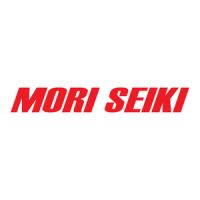2-120 MACHINE OPERATIONS OPERACIONES DE MECANIZADO
3. When an arc cutting is executed in the
polar coordinate interpolation mode,
addresses to indicate the arc radius are
determined according to the axis name of
the linear axis.
If the X-axis is taken as the linear axis:
Since circular interpolation is assumed to
be executed in the XY plane, addresses I
and J are used to specify the arc radius.
(Initial setting)
If the Y-axis is taken as the linear axis:
Since circular interpolation is assumed to
be executed in the YZ plane, addresses J
and K are used to specify the arc radius.
If the Z-axis is taken as the linear axis:
Since circular interpolation is assumed to
be executed in the ZX plane, addresses I
and K are used to specify the arc radius.
Note an arc radius may be specified using
address R.
4. In the polar coordinate interpolation mode,
never change the coordinate system
(G50, G52, G53, G54 to G59, etc.).
5. In the polar coordinate interpolation mode,
the G00 command cannot be specified.
Only the following G codes can be speci-
fied.
G01, G02, G03, G04, G40, G41, G42,
G65, G66, G67, G98, and G99
6. In the cutter radius offset mode or the
automatic tool nose radius offset mode,
the G12.1 (G112) and G13.1 (G113) com-
mands cannot be specified.
Before specifying the G12.1 (G112) or
G13.1 (G113) command, cancel the cutter
radius offset mode or the automatic tool
nose radius offset mode.
7. For "X" of the TOOL GEOMETRY OFF-
SET screen, set the distance from the cen-
ter of spindle to the center of a rotary tool
with the turret returned to the zero point.
For "R" of the TOOL GEOMETRY OFF-
SET screen, set the radius of the rotary
tool.
8. With headstock 2 specifications, the polar
coordinate interpolation function can be
used for spindle 2 in addition to spindle 1.
If the polar coordinate interpolation func-
tion is used in the spindle 2 operation, pay
attention to the "+/−" direction of the Z-
and C-axis.
Concerning the "+/−" direction of the Z- and
C-axis, refer to "Axis Control and Direction"
(page 1-79).
NOT A
3. Cuando se ejecute el corte de arco en el modo de
interpolación de coordenadas polares, se deter-
minarán las direcciones para indicar el radio del
arco de acuerdo con el nombre del eje lineal.
Si el eje X se toma como el eje lineal:
Dado que se asume que la interpolación circular
se ejecutará en el plano XY, las direcciones I y J
se utilizan para especificar el radio del arco.
(Ajuste inicial)
Si el eje Y se toma como el eje lineal:
Dado que se asume que la interpolación circular
se ejecutará en el plano YZ, las direcciones J y K
se utilizan para especificar el radio del arco.
Si el eje Z se toma como el eje lineal:
Dado que se asume que la interpolación circular
se ejecutará en el plano ZX, las direcciones I y K
se utilizan para especificar el radio del arco.
Tenga en cuenta que podrá especificarse un
radio del arco usando la dirección R.
4. En el modo de interpolación de coordenadas
polares, nunca cambie el sistema de coordena-
das (G50, G52, G53, G54 a G59, etc.).
5. En el modo de interpolación de coordenadas
polares, no podrá especificarse la instrucción
G00. Sólo podrán especificarse los códigos G
siguientes.
G01, G02, G03, G04, G40, G41, G42, G65, G66,
G67, G98 y G99
6. En el modo de corrección de radio del cortador o
en modo de corrección automática del radio de la
nariz de la herramienta, no pueden especificarse
las instrucciones G12.1 (G112) ni G13.1 (G113).
Antes de especificar la instrucción G12.1 (G112)
o G13.1 (G113), cancele el modo de corrección
del radio de cortador o el modo de corrección
automática del radio de la nariz de herramienta.
7. Para "X" en la pantalla CORRECCIÓN GEOME-
TRÍA DE HRRTA, ajuste la distancia desde el
centro del husillo al centro de una herramienta
giratoria habiendo regresado la torreta al punto
cero. Para "R" de la pantalla CORRECCIÓN
GEOMETRÍA DE HRRTA, ajuste el radio de la
herramienta giratoria.
8. Con las especificaciones de cabezal fijo 2, la fun-
ción de interpolación de coordenadas polares
podrá usarse para el husillo 2 además del
husillo 1. Si se usa la función de interpolación de
coordenadas polares en la operación de husillo 2,
fíjese en la dirección "+/−" del eje Z y C.
Para obtener información sobre la dirección
"+/−" del eje Z y C, consulte "Control del eje y
dirección" (página 1-79).

